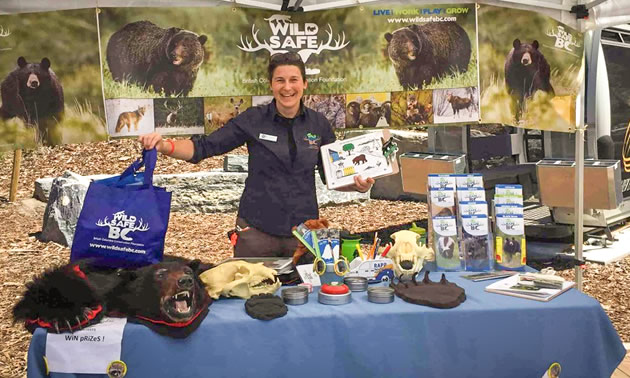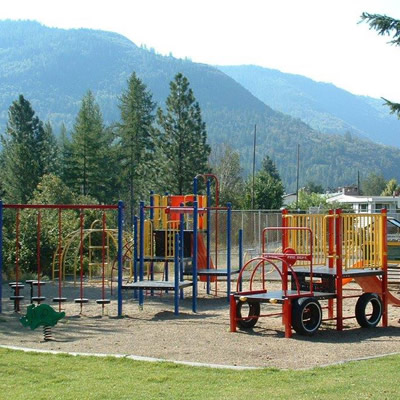Keeping Wild Things Wild
The Foundation’s WildSafeBC program is designed to reduce human and wildlife conflict.

WildSafe BC employee Johanne Lamoureux educates the public at a Bear Smart Community workshop. — Photo courtesy WildSafe BC
Wildlife like cougars and bears are impressive, and usually spend their time doing their own things and going their own ways. But add an unexpected human, or possible temptations like unsecured garbage or fruit trees, and the results could be terrible.
That’s where WildSafeBC comes in. To minimize attractants and human-wildlife contact—and therefore human-wildlife conflicts—the Trust has been partnering with the British Columbia Conservation Foundation since 2009.
The Foundation’s WildSafeBC program “is designed to reduce human and wildlife conflict through collaboration, education and community solutions,” says Jen Bellhouse, the Foundation’s Regional Manager. This means that people in the region get the tools and knowledge they need to keep themselves safe and ensure wildlife stays wild.
Last year saw many successes. For the second year in a row, Basin communities had fewer human-bear conflicts. In 2016, people reported 2,300 black bear incidents. In 2018, this was down to 1,032. Significantly fewer bears had to be relocated or destroyed.
WildSafeBC helped influence these numbers through its community coordinators. Up to 12 coordinators around the Basin provided workshops, knocked on doors, tagged wildlife-tempting garbage cans, set up booths at farmers’ markets, provided support with electric fencing, and more. In 2018 alone, these coordinators spoke directly to over 31,000 people in the Basin—and many others through social media—and supported residents in nearly 100 Basin communities.
One particularly successful community has been New Denver. “We support communities working on becoming certified by the Province as a Bear Smart Community,” says Vanessa Isnardy, the Provincial Coordinator for WildSafeBC. This Provincial program sets out 6 criteria that support the reduction of human-bear conflicts. “New Denver is one of only about eight communities in the province that have achieved this status, however there are over 20 which are working towards meeting these criteria.” As part of their commitment to being a Bear Smart Community, New Denver council updated their bylaws and over $30,000 was spent on bear-resistant containers on municipal property. The Village of New Denver has also supported electric fencing workshops and has been a model for their proactive approaches.

WildSafe BC is committed to reducing the number of human-bear conflicts. — Photo courtesy WildSafe BC
With the Trust’s continued support, in 2018 WildSafeBC also collaborated with more partners and local governments. It brought coordinators to new communities, including Valemount, Warfield, Fruitvale and Montrose. It reached out more to people in many of the smaller communities around Koocanusa Reservoir, the Elk Valley and the rural areas outside Kimberley and Cranbrook.
Reducing wildlife attractants continued to be a key focus. In Sparwood, the coordinator helped residents obtain 1,700 bear-resistant garbage bins. In Invermere, the coordinator worked with the Groundswell Network Society to implement a pilot program to pick fruit—reducing attractants, diverting waste from the landfill and educating people about food systems. In Kaslo, the coordinator worked with Kootenay Waste Services to develop a plan to provide household garbage pickup for residents in the Lardeau Valley.
The program is now gearing up for an equally notable 2019. Ever want to learn how to safely use bear spray? Now’s the time. Along with all their other efforts, this year WildSafeBC coordinators will be helping people in the Basin become more familiar and comfortable with this effective bear deterrent.
Already, community coordinators are resuming their programs throughout the region. Expect to see them in Castlegar, Cranbrook/Kimberley, Creston/Selkirk Purcells, Fernie/Elk Valley, Golden, Invermere, Kaslo, Nelson, New Denver, Radium/Fairmont and Rossland/Trail.
To support this work in the Basin, the Trust recently committed $240,000 over three years to WildSafeBC. Other major funders include the Province’s Ministry of Environment and municipal and regional governments.
“With our funding from the Trust, we are able to start our season early—mid-April—and end later in the fall,” says Bellhouse. “Our community coordinators will be able to work more hours to reach more people in the Basin. It also means we can be flexible in how we tailor our activities for the needs of individual communities. It means a lot for the program.”
As the snow finally recedes from our yards and gardens and new leaves emerge, our wild neighbours are also on the move. Stay safe and keep the animals safe by connecting with your local WildSafeBC community coordinator. What you learn and do could positively impact a life.
To learn more, visit wildsafebc.com or find WildSafeBC on Facebook, Twitter or Instagram.





Comments